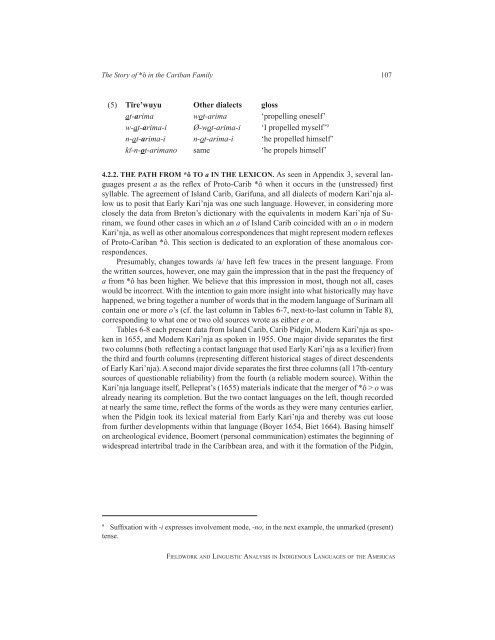Fieldwork and Linguistic Analysis in Indigenous ... - ScholarSpace
Fieldwork and Linguistic Analysis in Indigenous ... - ScholarSpace
Fieldwork and Linguistic Analysis in Indigenous ... - ScholarSpace
You also want an ePaper? Increase the reach of your titles
YUMPU automatically turns print PDFs into web optimized ePapers that Google loves.
The Story of *ȏ <strong>in</strong> the Cariban Family 107<br />
(5) Tïre’wuyu Other dialects gloss<br />
at-arima wot-arima ‘propell<strong>in</strong>g oneself’<br />
w-at-arima-i Ø-wot-arima-i ‘I propelled myself’ 9<br />
n-at-arima-i n-ot-arima-i ‘he propelled himself’<br />
kï-n-ot-arimano same ‘he propels himself’<br />
4.2.2. THE PATH FROM *ô TO a IN THE LEXICON. As seen <strong>in</strong> Appendix 3, several languages<br />
present a as the reflex of Proto-Carib *ô when it occurs <strong>in</strong> the (unstressed) first<br />
syllable. The agreement of Isl<strong>and</strong> Carib, Garifuna, <strong>and</strong> all dialects of modern Kari’nja allow<br />
us to posit that Early Kari’nja was one such language. However, <strong>in</strong> consider<strong>in</strong>g more<br />
closely the data from Breton’s dictionary with the equivalents <strong>in</strong> modern Kari’nja of Sur<strong>in</strong>am,<br />
we found other cases <strong>in</strong> which an a of Isl<strong>and</strong> Carib co<strong>in</strong>cided with an o <strong>in</strong> modern<br />
Kari’nja, as well as other anomalous correspondences that might represent modern reflexes<br />
of Proto-Cariban *ô. This section is dedicated to an exploration of these anomalous correspondences.<br />
Presumably, changes towards /a/ have left few traces <strong>in</strong> the present language. From<br />
the written sources, however, one may ga<strong>in</strong> the impression that <strong>in</strong> the past the frequency of<br />
a from *ô has been higher. We believe that this impression <strong>in</strong> most, though not all, cases<br />
would be <strong>in</strong>correct. With the <strong>in</strong>tention to ga<strong>in</strong> more <strong>in</strong>sight <strong>in</strong>to what historically may have<br />
happened, we br<strong>in</strong>g together a number of words that <strong>in</strong> the modern language of Sur<strong>in</strong>am all<br />
conta<strong>in</strong> one or more o’s (cf. the last column <strong>in</strong> Tables 6-7, next-to-last column <strong>in</strong> Table 8),<br />
correspond<strong>in</strong>g to what one or two old sources wrote as either e or a.<br />
Tables 6-8 each present data from Isl<strong>and</strong> Carib, Carib Pidg<strong>in</strong>, Modern Kari’nja as spoken<br />
<strong>in</strong> 1655, <strong>and</strong> Modern Kari’nja as spoken <strong>in</strong> 1955. One major divide separates the first<br />
two columns (both reflect<strong>in</strong>g a contact language that used Early Kari’nja as a lexifier) from<br />
the third <strong>and</strong> fourth columns (represent<strong>in</strong>g different historical stages of direct descendents<br />
of Early Kari’nja). A second major divide separates the first three columns (all 17th-century<br />
sources of questionable reliability) from the fourth (a reliable modern source). With<strong>in</strong> the<br />
Kari’nja language itself, Pelleprat’s (1655) materials <strong>in</strong>dicate that the merger of *ô > o was<br />
already near<strong>in</strong>g its completion. But the two contact languages on the left, though recorded<br />
at nearly the same time, reflect the forms of the words as they were many centuries earlier,<br />
when the Pidg<strong>in</strong> took its lexical material from Early Kari’nja <strong>and</strong> thereby was cut loose<br />
from further developments with<strong>in</strong> that language (Boyer 1654, Biet 1664). Bas<strong>in</strong>g himself<br />
on archeological evidence, Boomert (personal communication) estimates the beg<strong>in</strong>n<strong>in</strong>g of<br />
widespread <strong>in</strong>tertribal trade <strong>in</strong> the Caribbean area, <strong>and</strong> with it the formation of the Pidg<strong>in</strong>,<br />
9 Suffixation with -i expresses <strong>in</strong>volvement mode, -no, <strong>in</strong> the next example, the unmarked (present)<br />
tense.<br />
fieldwork <strong>and</strong> l<strong>in</strong>guistic analysis <strong>in</strong> <strong>in</strong>digenous languages of the americas

















